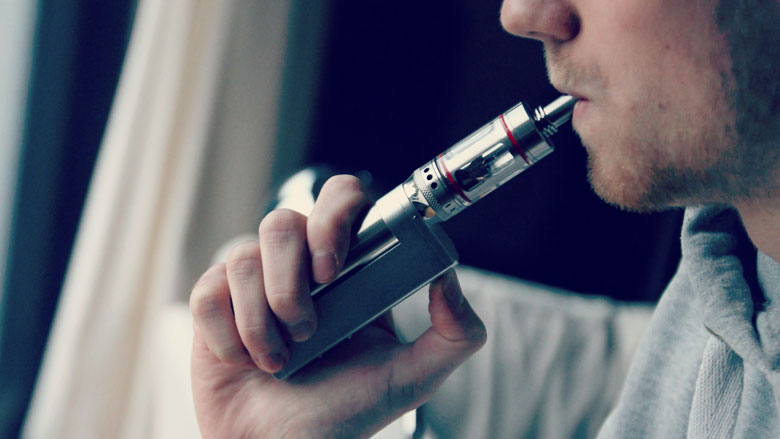Congress, save e-cigarettes from the FDA
By Sally Satel | July 7, 2016, 7:44 EDT
 Photo via Wikimedia, courtesy of flickr, https://vaping360.com/
Photo via Wikimedia, courtesy of flickr, https://vaping360.com/ In April, House appropriators faced a decision with major ramifications for efforts to combat smoking and protect public health. The Food and Drug Administration is poised to adopt rules that could cripple the e-cigarette industry, obstructing the availability of a safer alternative to cigarettes. The appropriators might be the last line of defense against wrong-headed action by the FDA.
E-cigarettes, and vaping products more generally, don’t burn tobacco, allowing them to deliver the nicotine that smokers crave without the cancer-causing tar that kills them. The nicotine solution contains flavoring and propylene glycol which, based on current evidence, is safe when inhaled over the short term – long term follow-up is needed to observe if any harmful effects show up later on. Smokers with asthma who have switched completely or partly to vaping products enjoy improved lung function and blood pressure.
Here’s the back story. In 2009, Congress gave the FDA power to regulate cigarettes and a few other tobacco products. Congress didn’t put e-cigarettes under FDA’s regulation, but it gave the FDA the option to extend its powers to cover e-cigarettes. In April 2014, FDA issued a proposal to do just that. FDA appears to be poised to finalize that proposal, putting e-cigarettes under the same rules as cigarettes.
Some of the FDA rules that apply to cigarettes should apply to e-cigarettes, like those that restrict access by minors. But, one part of the regulatory regime – the rules governing the introduction of new tobacco products – won’t work for e-cigarettes.
If a tobacco product wasn’t on the market on February 15, 2007, then the rules allow only two ways to introduce it. The manufacturer can show that the new product is substantially equivalent to something on the market on February 15, 2007. Or, the manufacturer can go through the costly and arduous process of filing a pre-market review application, which requires a large amount of scientific data.
Applying these rules to e-cigarettes would devastate the smaller vaping companies that account for much of the innovation in the industry. The problem is that there were almost no e-cigarettes on the market on February 15, 2007. So, almost no products would be grandfathered in and almost none of them could find a February 2007 product to which they’re substantially equivalent. In most cases, the only way to keep an e-cigarette product on the market would be to file a pre-market review application.
One part of the pre-market review process – the requirement that manufacturers demonstrate the safety of the devices and e-liquid – is welcome. But, two elements of the process are most worrisome. First, applicants must present research findings on the impact of the product on the population as a whole, including an examination of the likelihood of former smokers re-initiating tobacco use with the new product and the likelihood of smokers switching to the product instead of quitting completely or trying to quit with an FDA-approved medication. Second, applicants are required to demonstrate that the new product is beneficial to the public’s health by showing that it has a negligible (however that may be defined) impact on nonsmokers – especially youth – who might use the new product.
Performing the necessary investigations is extremely burdensome. The FDA estimates that it costs about $300,000 to prepare and file an application – some outside observers think the actual cost may top $2 million. In fact, the process is so arduous that cigarette companies have filed only a handful of pre-market review applications for new cigarette products since 2009. Now, multiply these demands by a factor of 10s to 100s, to account for an entirely new assessment for each device or e-liquid that a company makes.
Beyond the financial burden, though, the bigger problem is that some of the demands are completely unrealistic. As tobacco researcher Lynn Kozlowski and tobacco expert David Sweanor recently pointed out, some of FDA’s proposed rules pose a “near-impossible task, a barrier that no product has yet surmounted, and one not imposed on other FDA-regulated product categories.” Collecting data on long-term health effects is important, but it makes more sense to collect such data post-market rather than holding up approval for the years it can take to collect meaningful evidence.
For products like e-cigarettes, which pose many fewer risks than cigarettes, requiring pre-market review of public health impact probably doesn’t make sense at all. But, if it’s going to apply, then the February 15, 2007 date has to be changed.
FDA doesn’t want to change the date. And, even if it wanted to, it may not have the legal power to change it, so long as it regulates e-cigarettes at all. FDA has offered a grace period, giving sellers two years to file their pre-market review applications and allowing products to be sold while the applications are reviewed. But, that just postpones the day of reckoning.
It looks like only Congress can fix this problem. In April, the House Appropriations Committee’s agriculture subcommittee passed a provision, the Cole Amendment, requiring the FDA to change the February 15, 2007 date to the date on which the FDA’s final rule takes effect, set for August 8, 2016. Products on the market then, and new products substantially equivalent to them, wouldn’t have to file pre-market review applications.
Before final passage, the provision should ensure, though, that all e-cigarette products, regardless of the date they’re introduced, would be subject to labeling restrictions, prohibitions on distributions to minors, ingredient-listing rules, retailer-registration requirements, best manufacturing practices, battery safety, prohibitions on adulteration and misbranding, and other sensible regulations. Some, but not all of these protections, are in the Cole Amendment.
It was one thing for Congress to put heavy roadblocks in front of new cigarette products introduced after 2007. Our country already had a lot of cigarette products in 2007 and we don’t need many more brands and varieties of that deadly substance. But, it would be absurd to put the same barricade in front of virtually every e-cigarette product in the country, when e-cigarettes offer the potential to move people away from smoking.
Congress should stop the FDA from undermining e-cigarette innovation and availability.
Alan D. Viard, a resident scholar at the American Enterprise Institute, co-authored this article.

Sally Satel
Sally Satel is a psychiatrist specializing in addiction medicine, a resident scholar at the American Enterprise Institute, and a lecturer at the Yale University School of Medicine.
A version of this article first appeared on Forbes.











